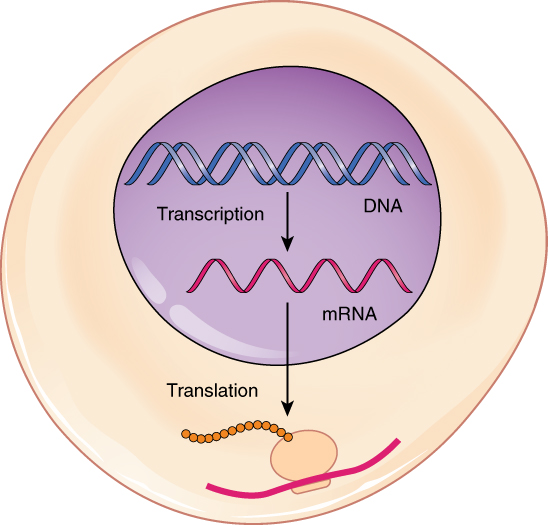7.1 Introduction
Learning Objectives
- Discuss what is meant by “The Central Dogma” of Biology.
- Describe the Beadle and Tatum experiments which led to the “One gene, One enzyme” hypothesis.
- Outline the use of genetic screens for mutations and applications to biochemical pathway analysis.
How is the genetic information in DNA (genes) expressed as biological traits, such as the flower colour of Mendel’s peas? The answer lies in what has become known as molecular biology’s Central Dogma. While not all genes code for proteins, most do (Figure 7.1.1). This chapter describes the Central Dogma and some experiments that were used to support this concept.

When we think of the word “mutation”, we automatically think of it as something negative or detrimental. However, a mutation, which is a change in the DNA sequence, may have one or more effects on an organism, depending on what it is and in which gene it occurs. While detrimental effects are most common, sometimes mutations can create new features. These mutations give us a tool with which to investigate the gene and the biological processes in which it is involved.
We will first take a look at how scientists perform genetic screening for mutations, and the various consequences of those mutations.

The Central Dogma of Biology describes the concept that genetic information is encoded in DNA in the form of genes (Figure 7.1.3). This information is then transferred as needed, in a process called transcription into a messenger RNA (mRNA) sequence. The information is then transferred again, in a process called translation into a polypeptide (protein) sequence. The sequence of bases in DNA directly dictates the sequence of bases in the RNA, which in turn dictates the sequence of amino acids that make up a polypeptide.
The original core of the Central Dogma is that genetic information is NEVER transferred from protein back to nucleic acids. In certain circumstances, the information in RNA may be converted back to DNA through a process called reverse transcription. As well, DNA, and its information, can also be replicated.
Proteins do most of the “work” in a cell. They (1) catalyze the formation and breakdown of most molecules within an organism, as well as (2) form their structural components, and (3) regulate the expression of genes. By dictating the sequence and thus structure of each protein, DNA directs the function of that protein, which can thereby, affect the entire organism. Thus, the genetic information, or genotype, defines the potential form, or phenotype of the organism. Note, however, that the environment can also influence phenotype.

In the case of Mendel’s peas, purple-flowered plants have a gene that encodes an enzyme that produces a purple pigment molecule. In the white-flowered plants (a pigment-less mutant), the DNA for this gene has been changed, or mutated, so that it no longer encodes a functional protein. This is an example of a spontaneous, natural mutation in a gene coding for an enzyme in a biochemical pathway.
Life depends on (bio)chemistry to supply energy and to produce the molecules that construct and regulate cells. In 1908, Archibald Garrod described “in-born errors of metabolism” in humans using the congenital disorder, alkaptonuria (black urine disease), as an example of how “genetic defects” (genotype) led to the lack of an enzyme in a biochemical pathway and caused a disease (phenotype). The reason why people with alkaptonuria have black urine is because a chemical, called “alkapton”, makes urine black when exposed to air. In normal people, enzymes catalyze the reaction to break down alkapton, but people who are born with the disease, due to genetic defect, cannot make such enzymes and, therefore, cannot break down alkapton. Garrod’s work gave huge impact to modern genetics as it attempted to explain the biochemical mechanism behind the genes proposed in Mendelian genetics.
Take a look at the video below, Inborn Error of Metabolism: Alkaptonuria, by Walter Jahn (2016) on YouTube, which describes alkaptonuria.
Media Attributions
- Figure 7.1.1 0328 Transcription-translation Summary from Betts et al. (2013), OpenStax, CC BY 4.0, via Wikimedia Commons
- Figure 7.1.2 Canadian Sphynx Red by Tgianf75, CC BY-SA 3.0, via Wikimedia Commons
- Figure 7.1.3 Central Dogma of Molecular Biochemistry with Enzymes by Daniel Horspool [Dhorspool] at en.wikipedia, CC BY-SA 3.0, via Wikimedia Commons
References
Betts et al. (2013, April 25). Figure 3.29 From DNA to Protein: Transcription through Translation [digital image]. In Anatomy and Physiology. OpenStax. https://openstax.org/books/anatomy-and-physiology/pages/3-4-protein-synthesis
Jahn, W. (2016, July 16). Inborn error of metabolism: Alkaptonuria (video file). YouTube. https://www.youtube.com/watch?v=T6QDc7TCrv4
Long Descriptions
- Figure 7.1.1 The central dogma of molecular biology is represented by a cell which contains the nucleus, where transcription of DNA is facilitated to produce mRNA, which is then transported out of the nucleus into the cytoplasm, where translation on the ribosome then takes place, which produces proteins. [Back to Figure 7.1.1]
- Figure 7.1.2 The Canadian Sphynx Lack Hair Due to a Genetic Mutation. This breed originated in Minnesota, but the Canadian Sphynx line was started in Toronto in 1966 through a selective breeding program from a spontaneous mutation that gave naked kittens. This mutation is inherited in an autosomal recessive manner for the hairlessness gene. [Back to Figure 7.1.2]
- Figure 7.1.3 The central dogma of molecular biology is shown to be represented by first, replication of DNA before cell division, then secondly, transcription of DNA is facilitated to produce mRNA, followed finally by translation on the ribosome to produce polypeptides. [Back to Figure 7.1.3]

